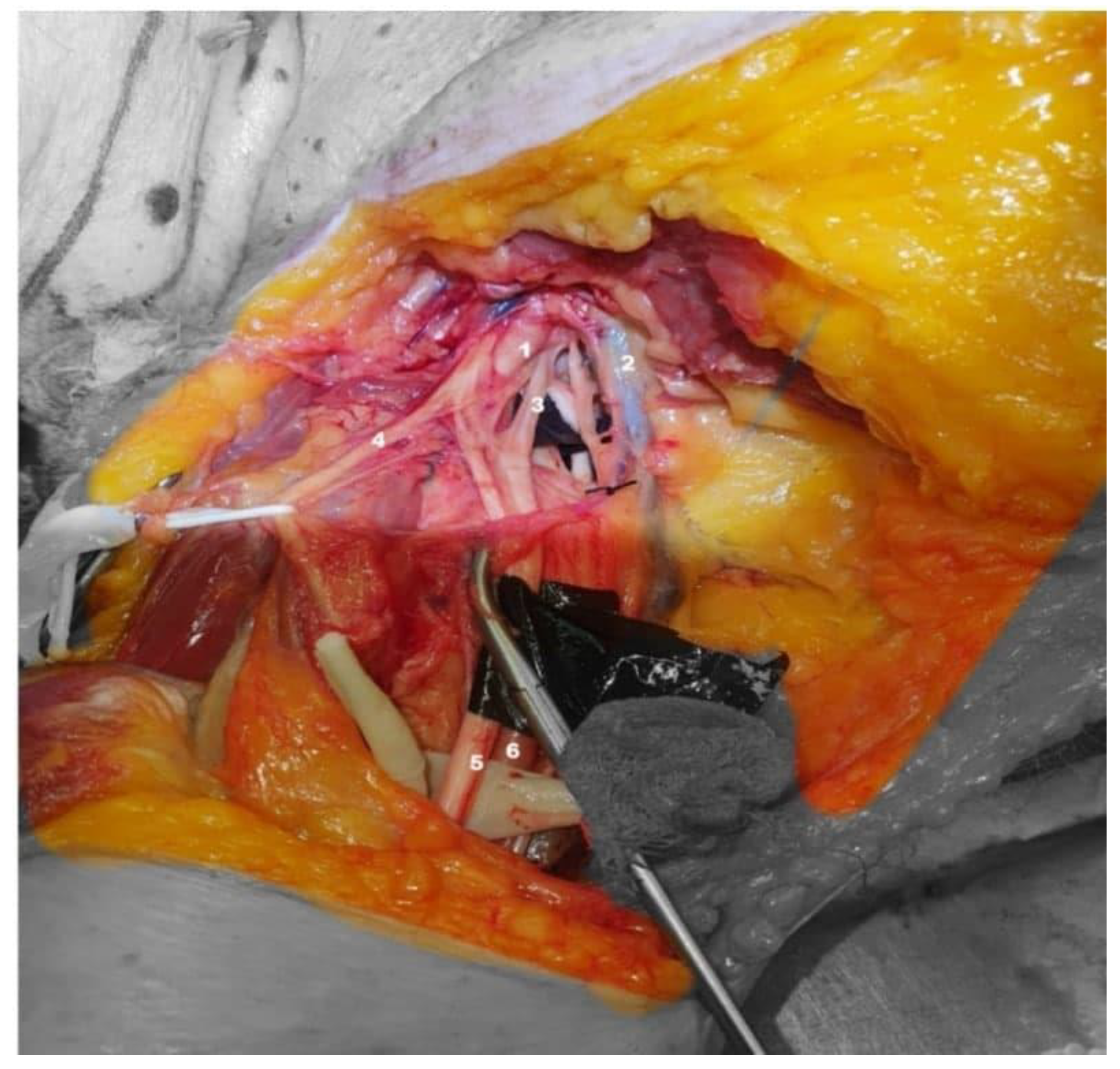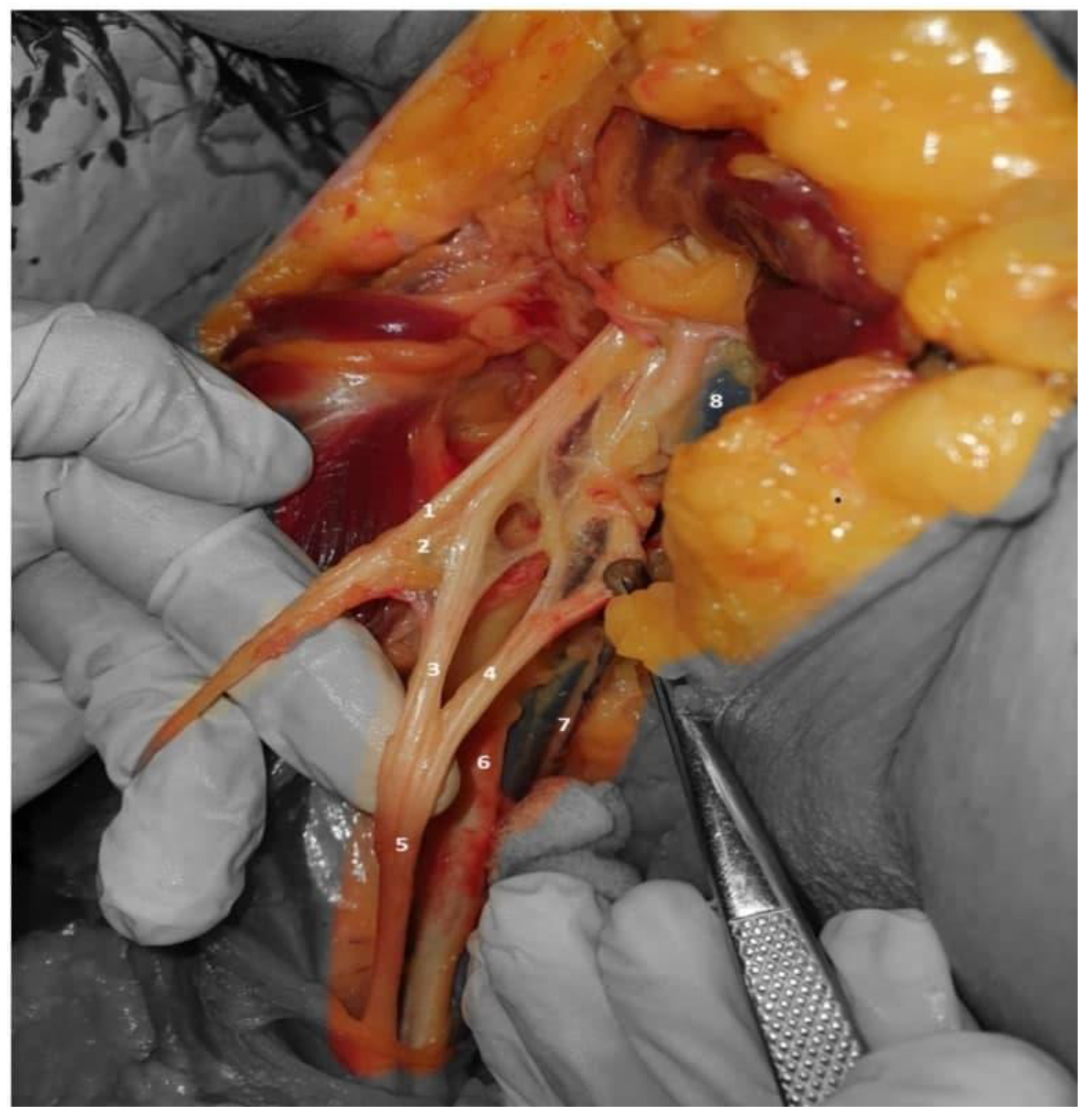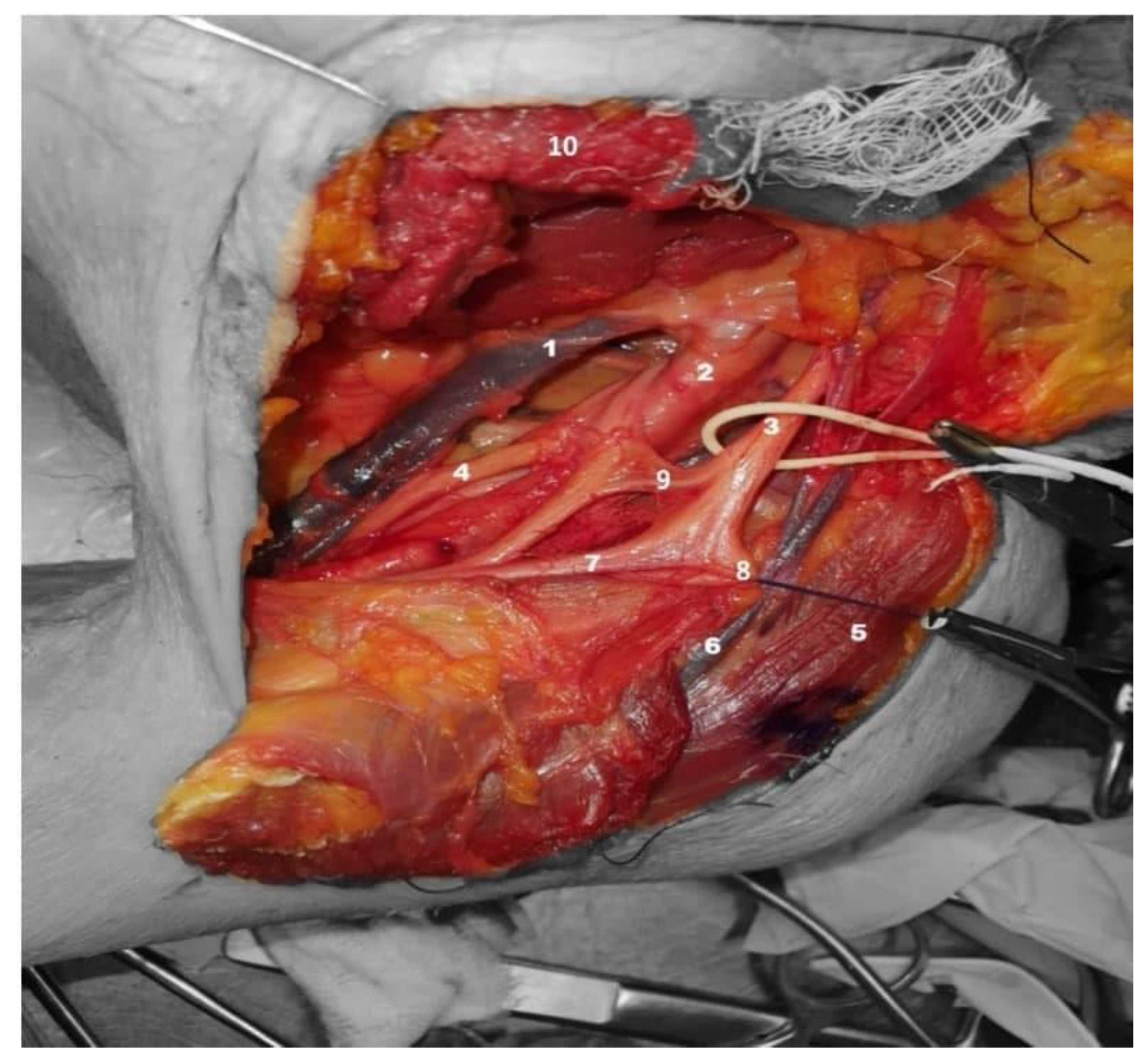Anatomical Variations of the Median Nerve: A Cadaveric Study
Abstract
1. Introduction
2. Materials and Methods
2.1. Data Acquisition
2.2. Dissection Technique
2.3. Ethical and Bioethical Principles
3. Results
4. Discussion
Limitations of the Study
5. Conclusions
Author Contributions
Funding
Institutional Review Board Statement
Informed Consent Statement
Data Availability Statement
Conflicts of Interest
References
- Rouvière, H.; Delmas, A.; Delmas, V. Anatomía humana: Descriptiva, topográfica y funcional. Barc. Masson 2005, 2, 198. [Google Scholar]
- Agarwal, R.; Gaur, S.; Kataria, S.K.A. Cadaveric study of variations in the formation of median nerve. Indian J. Neurosci. 2017, 3, 35–37. [Google Scholar]
- Almejo, L.L.; Correa, J.F.C.; Becerra, E.N.; Sahagún, J.Á.V.; Zermeño, R.J.J.; Kelley, A.F.E.d.; Rascón, J.C.L.; Mendoza, I.G. Síndrome del pronador. Orthotips AMOT 2014, 10, 46–57. [Google Scholar]
- Agarwal, P.; Gupta, S.; Yadav, P.; Sharma, D. Cadaveric study of anatomical variations of the median nerve and persistent median artery at wrist. Indian J. Plast. Surg. 2014, 47, 95. [Google Scholar] [CrossRef] [PubMed]
- Atoni, A.; Oyinbo, C. Anatomic Variation of the Median Nerve Associated with an Anomalous Muscle of the Forearm. Folia Med. 2017, 59, 1. [Google Scholar] [CrossRef] [PubMed]
- Natsis, K.; Paraskevas, G.; Tzika, M. Five Roots Pattern of Median Nerve Formation. Acta Med. 2016, 59, 26–28. [Google Scholar] [CrossRef][Green Version]
- Butz, J.; Shiwlochan, D.; Brown, K.; Prasad, A.; Murlimanju, B.; Viswanath, S. Bilateral variations of brachial plexus involving the median nerve and lateral cord: An anatomical case study with clinical implications. Australas. Med. J. 2014, 7, 21. [Google Scholar] [CrossRef]
- Chrysikos, D.; Papapostolou, S.; Samolis, A.; Antonopoulos, I.; Troupis, T. Anatomical variation of a trifid (trifurcation) lateral root origin of the median nerve. Folia Morphol. 2020, 79, 860–862. [Google Scholar] [CrossRef]
- Clarke, E.; Tubbs, R.S.; Radek, M.; Haładaj, R.; Tomaszewski, M.; Wysiadecki, G. Unusual formation of the musculocutaneous and median nerves: A case report refined by intraneural dissection and literature review. Folia Morphol. 2021, 80, 1020–1026. [Google Scholar] [CrossRef]
- Samarawickrama, M. A study of anatomical variations of median nerve formation and its relation to the arteries in the axilla and arm. Int. J. Morphol. 2017, 35, 698–704. [Google Scholar] [CrossRef][Green Version]
- Kumari, K.; Rao, M.; Ashalatha, D.; Elena, G.; Sailaja, L. Anatomical variation in the formation and course of median nerve: A cadaveric study. Int. J. Res. Med. Sci. 2015, 1, 1345–1347. [Google Scholar] [CrossRef][Green Version]
- Reis, F. Study of the Anatomical Variations of the Median Nerve in Human Fetuses. Annu. Res. Rev. Biol. 2014, 4, 2347–2356. [Google Scholar] [CrossRef]
- Patil, D.; Jadhav, A.; Bhingardeve, C.; Katti, A. Variation in the formation, communication and distribution of median nerve: A cadaveric study. Asian Pac. J. Health Sci. 2016, 3, 17–22. [Google Scholar] [CrossRef]
- Chitra, P.; Anandhi, V. A Study of the different types of formation of the median nerve. Int. J. Anat. Res. 2016, 4, 2397–2400. [Google Scholar] [CrossRef]
- Mat Taib, C.; Hassan, S.; Esa, N.; Mohd Moklas, M.; San, A. Anatomical variations of median nerve formation, distribution and possible communication with other nerves in preserved human cadavers. Folia Morphol. 2017, 76, 38–43. [Google Scholar] [CrossRef] [PubMed]
- Bharti, A.; Paranjpe, V.M.; Apte, M.V. Variations in the formation and relation of median nerve. Int. J. Anat. Res. 2015, 3, 1298–1301. [Google Scholar] [CrossRef]
- Chitra, R. Multiple bilateral neuroanatomical variations of the nerves of the arm. Neuroanatomy 2007, 6, 43–45. [Google Scholar]
- Roy, J.; Henry, B.M.; PĘkala, P.A.; Vikse, J.; Saganiak, K.; Walocha, J.A.; Tomaszewski, K.A. Median and ulnar nerve anastomoses in the upper limb: A meta-analysis. Muscle Nerve 2016, 54, 36–47. [Google Scholar] [CrossRef]
- Perrini, P.; Montemurro, N. Congenital absence of a cervical spine pedicle. Neurol. India 2016, 64, 189–190. [Google Scholar] [CrossRef]
- Nimma, A.; Bhat, S. Bilateral Martin-Gruber and Marinacci Anastomoses in the Same Patient: A Case Report. Neurodiagn. J. 2020, 60, 185–194. [Google Scholar] [CrossRef]
- Schroeder, G.D.; Canseco, J.A.; Patel, P.D.; Divi, S.N.; Karamian, B.A.; Kandziora, F.; Vialle, E.N.; Oner, F.C.; Schnake, K.J.; Dvorak, M.F.; et al. Establishing the Injury Severity of Subaxial Cervical Spine Trauma: Validating the Hierarchical Nature of the AO Spine Subaxial Cervical Spine Injury Classification System. Spine 2021, 46, 649–657. [Google Scholar] [CrossRef] [PubMed]
- Burakgazi, A.Z.; Russo, M.; Bayat, E.; Richardson, P.K. Ulnar neuropathy with prominent proximal Martin-Gruber anastomosis. Int. J. Neurosci. 2014, 124, 542–546. [Google Scholar] [CrossRef] [PubMed]
- Rodriguez-Niedenführ, M.; Vazquez, T.; Ferreira, B.; Parkin, I.; Nearn, L.; Sañudo, J.R. Intramuscular Martin-Gruber anastomosis. Clin. Anat. 2002, 15, 135–138. [Google Scholar] [CrossRef]
- Montemurro, N.; Ortenzi, V.; Naccarato, G.A.; Perrini, P. Angioleiomyoma of the knee: An uncommon cause of leg pain. A systematic review of the literature. Interdiscip. Neurosurg. 2020, 22, 100877. [Google Scholar] [CrossRef]
- Montemurro, N.; Scerrati, A.; Ricciardi, L.; Trevisi, G. The Exoscope in Neurosurgery: An Overview of the Current Literature of Intraoperative Use in Brain and Spine Surgery. J. Clin. Med. 2021, 11, 223. [Google Scholar] [CrossRef]
- Mishra, R.; Narayanan, M.D.K.; Umana, G.E.; Montemurro, N.; Chaurasia, B.; Deora, H. Virtual Reality in Neurosurgery: Beyond Neurosurgical Planning. Int. J. Environ. Res. Public Health 2022, 19, 1719. [Google Scholar] [CrossRef]
- Tschabitscher, M.; Di Ieva, A. Practical guidelines for setting up an endoscopic/skull base cadaver laboratory. World Neurosurg. 2013, 79, S16.e1–S16.e7. [Google Scholar] [CrossRef]



| N° | (%) | |
|---|---|---|
| Overall anatomical bodies | 42 | 100 |
| Sex | ||
| Male | 21/42 | 50 |
| Female | 21/42 | 50 |
| Area of origin of the median nerve | ||
| Axillary region | 78/84 | 92.9 |
| Brachial region | 6/84 | 7.1 |
| Anatomical variation * in the formation of the median nerve | 19/84 | 22.6 |
| Male | 9/42 | 81.8 |
| Female | 2/42 | 18.2 |
| Number of roots that form the median nerve | ||
| 2 | 65/84 | 77.4 |
| 3 | 17/84 | 20.2 |
| 4 | 2/84 | 2.4 |
| Anatomical variation * of the median nerve according to the side of the body | ||
| Unilateral | 3/42 | 7.1 |
| Bilateral | 8/42 | 19 |
| Origin of the additional variation * root in median nerve formation | ||
| Medial fascicle | 2/84 | 2.4 |
| Lateral fascicle | 17/84 | 20.2 |
Publisher’s Note: MDPI stays neutral with regard to jurisdictional claims in published maps and institutional affiliations. |
© 2022 by the authors. Licensee MDPI, Basel, Switzerland. This article is an open access article distributed under the terms and conditions of the Creative Commons Attribution (CC BY) license (https://creativecommons.org/licenses/by/4.0/).
Share and Cite
Encarnacion, M.; Nurmukhametov, R.; Barrientos, R.E.; Melchenko, D.; Goncharov, E.; Bernard, E.; Huerta, J.M.; Uhl, J.F.; Efe, I.E.; Montemurro, N.; et al. Anatomical Variations of the Median Nerve: A Cadaveric Study. Neurol. Int. 2022, 14, 664-672. https://doi.org/10.3390/neurolint14030054
Encarnacion M, Nurmukhametov R, Barrientos RE, Melchenko D, Goncharov E, Bernard E, Huerta JM, Uhl JF, Efe IE, Montemurro N, et al. Anatomical Variations of the Median Nerve: A Cadaveric Study. Neurology International. 2022; 14(3):664-672. https://doi.org/10.3390/neurolint14030054
Chicago/Turabian StyleEncarnacion, Manuel, Renat Nurmukhametov, Rossi Evelyn Barrientos, Dmitry Melchenko, Evgeniy Goncharov, Edwin Bernard, Jose Mogorron Huerta, Jean Francois Uhl, Ibrahim E. Efe, Nicola Montemurro, and et al. 2022. "Anatomical Variations of the Median Nerve: A Cadaveric Study" Neurology International 14, no. 3: 664-672. https://doi.org/10.3390/neurolint14030054
APA StyleEncarnacion, M., Nurmukhametov, R., Barrientos, R. E., Melchenko, D., Goncharov, E., Bernard, E., Huerta, J. M., Uhl, J. F., Efe, I. E., Montemurro, N., & Ramirez, I. (2022). Anatomical Variations of the Median Nerve: A Cadaveric Study. Neurology International, 14(3), 664-672. https://doi.org/10.3390/neurolint14030054








